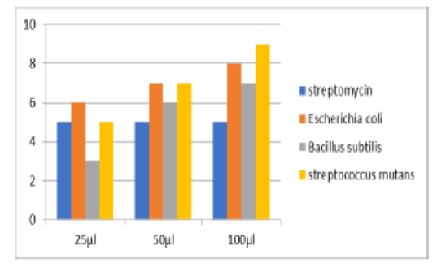


Indian Journal of Science and Technology
Year: 2023, Volume: 16, Issue: 9, Pages: 605-613
Original Article
S Nirmala1, R Siva2*
1Research Scholar, Department of Plant Biology and Plant Biotechnology, Shrimathi Devkunvar Nanalal Bhatt Vaishnav College for Women, Chrompet, Chennai
2Assistant Professor and Head, Department of Plant Biology and Plant Biotechnology, Shrimathi Devkunvar Nanalal Bhatt Vaishnav College for Women, Chrompet, Chennai
*Corresponding Author
Email: [email protected]
Received Date:27 November 2022, Accepted Date:06 January 2023, Published Date:02 March 2023
Objectives: To evaluate the efficacy of edible mushroom, Macrocybe gigantea for the biosynthesis of silver nanoparticles, antioxidant property and antibacterial property. Methods: M. gigantea pure culture was isolated using tissue culture in a petri-plate comprising potato dextrose agar (PDA) medium, spawn was prepared using sorghum grains and mushrooms were grown indoors using paddy straw in an uniquely designed environment for mushroom growth. The green synthesis of silver nanoparticles with AgNO3, antioxidant activity and antibacterial potential against a few food-borne bacteria were all investigated. The formation of AgNPs was further confirmed using a UV-Visible spectrophotometer. The silver nanoparticles were examined using Fourier-transform infrared spectroscopy (FTIR) and Scanning Electron Microscopy (SEM). The disc diffusion method was used to test the bacteriostatic and bactericidal activity of synthesised silver nanoparticles against selected food-borne bacteria such as Escherichia coli, Bacillus subtilis and Streptococcus mutans. Findings: The existence of phytochemicals such as alkaloids, terpenoids, phenols, flavonoids, proteins, and carbohydrates was revealed. Furthermore, the AgNPs produced from M.gigantea demonstrated absorbance at 420nm in a UV-Visible spectrophotometer. According to the SEM pictures, AgNPs appear spherical with diameters ranging from 50 to 70nm. At 100g/mL, the DPPH antioxidant assay exhibited the maximum percentage of inhibition of 67.94%, with an IC50 value of 57.07g/mL. The produced AgNPs also inhibited bacterial growth significantly. Green synthesised AgNPs from M.gigantea were produced in an environmentally friendly, quick and simple technique that functions as an antibacterial agent against certain food-borne pathogens such as E. coli, Bacillus subtilis, and Streptococcus mutans. The antibacterial screening demonstrates the biocidal ability of AgNPs from M.gigantea, which could be employed in the food processing and packaging industries. Novelty: This study is regarded as the first attempt to synthesise AgNPs from M.gigantea for use against food-borne bacteria.
Keywords: Macrocybe gigantea; Agnps; MycoNanoparticle; Antibacterial Activity; DPPH And Antioxidant
© 2023 Nirmala & Siva. This is an open-access article distributed under the terms of the Creative Commons Attribution License, which permits unrestricted use, distribution, and reproduction in any medium, provided the original author and source are credited. Published By Indian Society for Education and Environment (iSee)
Subscribe now for latest articles and news.